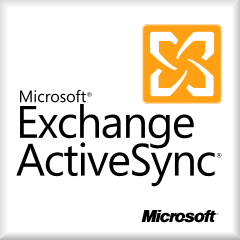You’ve told us that one of your top concerns is the increasing diversity of mobile devices that employees use to access your company resources. While many of these devices use Exchange ActiveSync (EAS) for mobile email, we all know that not all EAS clients are created equal. Exchange ActiveSync policies and features aren’t consistently implemented by licensees, so it can be challenging to find out what’s supported on each device.
 Today, we launched the Exchange ActiveSync Logo Program to establish baseline for EAS functionality in mobile email devices . The program is designed for device manufacturers that license the EAS protocol from Microsoft for use in mobile email clients that connect to Exchange. Wireless carriers may also join the program to include the Exchange brand to identify compliant devices for end-users. See Exchange ActiveSync Protocol for a list of current EAS licensees.
Today, we launched the Exchange ActiveSync Logo Program to establish baseline for EAS functionality in mobile email devices . The program is designed for device manufacturers that license the EAS protocol from Microsoft for use in mobile email clients that connect to Exchange. Wireless carriers may also join the program to include the Exchange brand to identify compliant devices for end-users. See Exchange ActiveSync Protocol for a list of current EAS licensees.
This qualification program includes a test plan defined by Microsoft and a third-party lab to qualify implementations by handset makers. Qualifying clients must use EAS v14 or later, and implement the following features and management policies. Information on these and other EAS features can be found in Exchange documentation on TechNet:
- Direct Push email, contacts & calendar
- Accept, Decline & Tentatively Accept meetings
- Rich formatted email (HTML)
- Reply/Forward state on email
- GAL Lookup
- Autodiscover
- ABQ strings (device type and device model) provided
- Remote Wipe
- Password Required
- Minimum Password Length
- Timeout without User Input
- Number of Failed Attempts
All Windows Phone 7 and Windows Phone 6.5 devices are compliant, as are Nokia devices running Mail for Exchange 3.0.50, including the Nokia E7, and Apple devices running iOS 4, including the iPhone 4, iPhone 3GS, iPad and iPad 2. We have a healthy pipeline of mobile device manufacturers ready to join the program and plan to announce additional participants in the coming months.
Over time, the program will evolve to require additional features and management policies. We hope this program is a first step in helping you manage mobile email devices in your enterprise.
For more info on managing your organization’s EAS devices, check out the previous post: Controlling Exchange ActiveSync device access using the Allow/Block/Quarantine list.
Greg Smiley
Senior Product Manager
Exchange Product Management